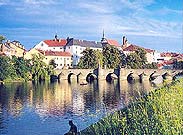| Home | ||||||||
 |
||||||||
|
OUR TORAH HISTORY When our local Jewish community began meeting as a group we would borrow Torahs from the coastal and Garberville communities. We learned of a collection of Holocaust Torahs being conserved by the Westminster Synagogue in England.
Our Czech Torah is MST#393 on Permanent loan from the Memorial Scrolls Trust
of a total of 1564 Torah scrolls that the Nazis had plundered that was formerly
believed to have been intended for a museum of an extinct race. Now historians
believe it was in fact a Jewish plan that saved the scrolls.
Over the course of a year the Torah is turned and read from beginning to end only to be re-rolled and the process begun again just after the Jewish New Year. May it be so. May life continue and may the Torah be read. Except in 1939, in Pisek, Czechoslovakia, a Torah written almost one hundred years ago stopped being turned. For it was confiscated by the Nazis and ordered along with all other Czech Torahs and Jewish religious objects to be gathered up and shipped to Prague, the capital. To Norm Rosen: Dear Sir, Thank you for your letter of October 30, 1996. It was a surprise, although I knew that the Torah from my town was in the U.S.. Pisek was a small town in Southern Bohemia,16,000 people beautifully situated among hills and forests with the River Optav flowing through it. In the summer it became a resort town. The synagogue was old, baroque, very well preserved. But we didn't have a rabbi. Once in a while we borrowed one. Pisek had about 300 Jews. After the war 3 came back. That's about it in a nutshell, the information you requested. With Best Wishes, Marta Hlavac In a phone conversation my husband had with Jan Frolich, a Holocaust Survivor from Pisek who now lives in Florida, he shared the following: Many members of the Pisek Jewish community were forced to walk to Poland only to be shot and put in unmarked graves. He was not among them because he was going to school in Prague. Instead he was sent to concentration camps. He survived Auschwitz and Dachau. In the 1990's, Steven Speilberg, for the Shoah Project, interviewed him about his experiences. The 300 Jews of Pisek save a few survivors became a part of the 80,000 Czech Jews who in turn became a part of the 6 million European Jews who were exterminated, slaughtered, shot, gassed, and perished during the Holocaust. The time we now call The Shoah, the destruction. The Torahs, the tree of life as it is seen by some of these Czech people, lived on. For it was by Nazi design that they become a part of a museum. A museum to an extinct race, an extinct Jewish race. But the Nazis were wrong. On May 5, 1945, the 12th unit of the United States Army liberated Pisek. After the Allied forces liberated Czechoslovakia the Torahs sat for the next 20 years in a warehouse in Prague and became badly deteriorated. In 1964, a London antique dealer convinced the Czech government to sell The Torahs. So all 1564 Czech Torahs were shipped to Westminster Synagogue in London. The business of repairing them took place over the next 30 years. They almost all showed evidence of the Holocaust. They were blood stained, charred by fire, and water damaged. Many still had the labels placed on them by the Nazis and some contained slips of paper with disparaging remarks on them. As the Torahs were repaired they were sent out to schools, hospitals, old age homes, and newly formed Jewish communities. In 1990 Westminster Czech Memorial Torah #393, the Pisek Torah, was given on permanent loan to a small Jewish community in Northern California. A community of 200-300 people who live near, in and around a town of 15,000-16,000, located in a beautiful valley surrounded by hills and forests with the Russian River flowing through it. A community like Pisek who didn't have a rabbi but borrowed one on occasion.
Once again the Torah was turned. First on the dining room table of my home then for almost ten years now on many occasions for the Sabbath, high holidays, and for rites of passage of our young people into adulthood-bar and bat mitzvahs. The people of Pisek are remembered each year during our Yiskor services, the memorial service where the names of our deceased loved ones are read, and they are remembered when the Kaddish, the mourner's prayer is said. In one hand I hold the joy and gratitude of having the Pisek Torah in our community. A Torah which we can wrap our fine traditions around. In the other hand I hold the horror and the pain of the Holocaust and the tragic deaths of the people of Pisek who perished. May they always be remembered. Author's note - In creating this piece I came across the names and dates of death of 97 people from Pisek who died in the camps. I posted them at the playhouse along with photos of our Torah. I am feeling compelled to light Yahrzeit candles on the anniversary dates of their deaths. I am including a list of names and anniversary dates which are in the next few months so anyone else, who feels drawn to, can also light candles. Here are the names and dates: 12/15/43- Bedrich Neumann
|
||||||||
|
Copyright 2005 Kol HaEmek. All Rights Reserved. |
||||||||
 Bridge at Pisek
Bridge at Pisek 